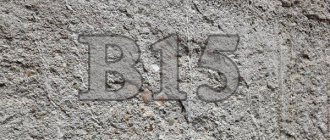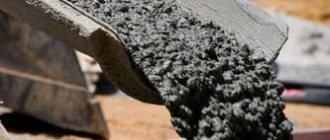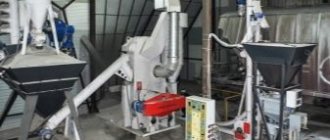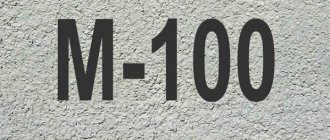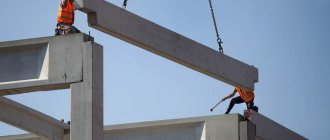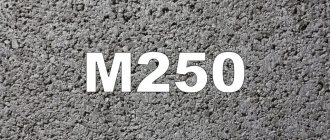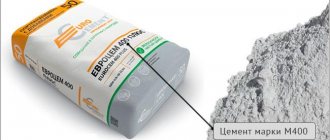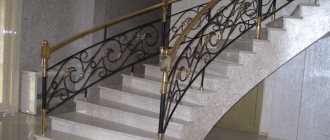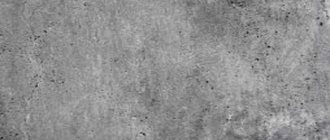GOST 26633-2015
INTERSTATE STANDARD
HEAVY AND FINE-GRAIN CONCRETE
Specifications
Heavy-weight and sand concretes. Specifications
_____________________________________________________________________ Text Comparison of GOST 26633-2015 with GOST 26633-2012, see the link. — Note from the database manufacturer. _____________________________________________________________________
ISS 91.100.30
Date of introduction 2016-09-01
Preface
The goals, basic principles and basic procedure for work on interstate standardization are established in GOST 1.0-2015 “Interstate standardization system. Basic provisions" and GOST 1.2-2015 "Interstate standardization system. Interstate standards, rules and recommendations for interstate standardization. Rules for the development, adoption, updating and information research center "Construction" by the Research, Design and Engineering and Technological Institute of Concrete and Reinforced Concrete named after A.A. Gvozdev (NIIZhB)
2 INTRODUCED by the Technical Committee for Standardization TC 465 “Construction”
3 ADOPTED by the Interstate Council for Standardization, Metrology and Certification (protocol dated December 10, 2015 N 48)
The following voted for adoption:
| Short name of the country according to MK (ISO 3166) 004-97 | Country code according to MK (ISO 3166) 004-97 | Abbreviated name of the national standardization body |
| Armenia | A.M. | Ministry of Economy of the Republic of Armenia |
| Kyrgyzstan | KG | Kyrgyzstandard |
| Russia | RU | Rosstandart |
4 By Order of the Federal Agency for Technical Regulation and Metrology dated March 17, 2016 N 165-st, the interstate standard GOST 26633-2015 was put into effect as a national standard of the Russian Federation on September 1, 2016.
5 INSTEAD GOST 26633-2012
6 REPUBLICATION. February 2022
Information about changes to this standard is published in the annual information index “National Standards”, and the text of changes and amendments is published in the monthly information index “National Standards”. In case of revision (replacement) or cancellation of this standard, the corresponding notice will be published in the monthly information index “National Standards”. Relevant information, notices and texts are also posted in the public information system - on the official website of the Federal Agency for Technical Regulation and Metrology on the Internet (www.gost.ru)
Areas and features of application
Concrete grade M400 has found its application in the field of industrial construction. It is there that its frost resistance and high strength are highly valued.
This building material is used for such large-scale work as:
- production of building floors bearing the main load;
- concreting areas where heavy equipment will be located;
- construction of dams, dams and drains;
- construction of underground storage facilities and tunnels;
- pouring supports for bridges, road junctions and viaducts;
- construction of monolithic walls in residential buildings.
It is not in demand in private construction due to its excess strength and rapid hardening speed.
Concrete grade M400 is a very strong and durable building material if the production process was carried out in compliance with all technological conditions. Then the constructed structures will last a very long time.
2 Normative references
This standard uses normative references to the following interstate standards:
GOST 4.212-80 System of product quality indicators. Construction. Concrete. Nomenclature of indicators
GOST 5578-94 Crushed stone and sand from ferrous and non-ferrous metallurgy slags for concrete. Specifications
GOST 7473-2010 Concrete mixtures. Specifications
GOST 8267-93 Crushed stone and gravel from dense rocks for construction work. Specifications
GOST 8269.1-97 Crushed stone and gravel from dense rocks and industrial waste for construction work. Chemical analysis methods
GOST 8735-88 Sand for construction work. Test methods
GOST 8736-2014 Sand for construction work. Specifications
GOST 10060-2012 Concrete. Methods for determining frost resistance
GOST 10178-85 Portland cement and Portland slag cement. Specifications
GOST 10180-2012 Concrete. Methods for determining strength using control samples
GOST 12730.1-78 Concrete. Methods for determining density
GOST 12730.5-84 Concrete. Methods for determining water resistance
GOST 13015-2012 Concrete and reinforced concrete products for construction. General technical requirements. Rules for acceptance, labeling, transportation and storage
GOST 13087-81 Concrete. Methods for determining abrasion
GOST 17623-87 Concrete. Radioisotope method for determining average density
GOST 17624-2012 Concrete. Ultrasonic method for determining strength
GOST 18105-2010 Concrete. Rules for monitoring and assessing strength
GOST 22266-2013 Sulfate-resistant cements. Specifications
GOST 22690-2015 Concrete. Determination of strength by mechanical methods of non-destructive testing
GOST 22783-77 Concrete. Method for accelerated determination of compressive strength
GOST 23732-2011 Water for concrete and mortars. Specifications
GOST 24211-2008 Additives for concrete and mortars. General technical conditions
GOST 24316-80 Concrete. Method for determining heat generation during hardening
GOST 24452-80 Concrete. Methods for determining prismatic strength, elastic modulus and Poisson's ratio
GOST 24544-81 Concrete. Methods for determining shrinkage and creep deformations
GOST 24545-81 Concrete. Endurance Test Methods
GOST 25192-2012 Concrete. Classification and general technical requirements
GOST 25592-91 Ash and slag mixtures from thermal power plants for concrete. Specifications
GOST 25818-2017 Fly ash from thermal power plants for concrete. Specifications
GOST 26644-85 Crushed stone and sand from thermal power plant slag for concrete. Specifications
GOST 27006-86 Concrete. Squad selection rules
GOST 27751-2014 Reliability of building structures and foundations. Basic provisions
GOST 28570-90 Concrete. Methods for determining strength using samples taken from structures
GOST 29167-91 Concrete. Methods for determining crack resistance characteristics (fracture toughness) under static loading
GOST 30108-94 Construction materials and products. Determination of specific effective activity of natural radionuclides
GOST 31108-2016 General construction cements. Specifications
GOST 31384-2017 Protection of concrete and reinforced concrete structures from corrosion. General technical conditions*
_______________ *Probably an error in the original. Should read: "requirements". — Note from the database manufacturer.
GOST 31424-2010 Non-metallic construction materials from screenings of crushing dense rocks in the production of crushed stone. Specifications
GOST 31914-2012 High-strength, heavy and fine-grained concrete for monolithic structures. Rules for quality control and assessment
GOST 32495-2013 Crushed stone, sand and sand-crushed stone mixtures from crushed concrete and reinforced concrete. Specifications
GOST 33174-2014 Public automobile roads. Cement. Technical requirements
GOST ISO/IEC 17025-2009 General requirements for the competence of testing and calibration laboratories
Note - When using this standard, it is advisable to check the validity of the reference standards in the public information system - on the official website of the Federal Agency for Technical Regulation and Metrology on the Internet or using the annual information index "National Standards", which was published as of January 1 of the current year, and on issues of the monthly information index “National Standards” for the current year. If the reference standard is replaced (changed), then when using this standard you should be guided by the replacing (changed) standard. If the reference standard is canceled without replacement, then the provision in which a reference is made to it is applied in the part that does not affect this reference.
Technical and operational characteristics
Concrete M350 belongs to heavy concrete mixtures and has the following technical and operational characteristics:
- high compressive strength;
- high abrasion resistance;
- good adhesion to reinforcement and reinforcing materials;
- homogeneity and low delamination;
- resistance to aggressive environments, sea water and climatic factors;
- resistance to temperature changes;
- resistance to cracking with proper care;
- maintainability and long service life of structures.
High technical and operational properties allow the widespread use of M350 concrete mortar in special areas of construction. Based on B25 concrete, heat-resistant, sulfate-resistant, screening, transport, road, hydraulic, heat-insulating, acid-resistant concrete, as well as fiber-reinforced concrete with various fiber fillers are produced.
3 Terms and definitions
This standard uses terms according to GOST 7473, GOST 13015, GOST 18105, GOST 24211, as well as the following terms with corresponding definitions:
3.1 concrete:
An artificial stone-like building material obtained as a result of molding and hardening of a rationally selected and compacted concrete mixture.
3.2 heavy concrete:
Concrete of a dense structure with an average density of more than 2000 to 2500 kg/m inclusive, based on cement binder and dense coarse and fine aggregates.
3.3 fine-grained concrete:
Concrete of a dense structure with an average density of more than 2000 to 2500 kg/m inclusive, on a cement binder and dense fine aggregate.
3.4 prefabricated concrete and reinforced concrete products:
Products made of concrete or reinforced concrete, intended for the construction of buildings and structures, manufactured outside the place of their final use.
3.5 monolithic concrete and reinforced concrete structures:
Structures made of concrete and reinforced concrete, manufactured directly on the construction site during the construction of buildings and structures.
3.6 supporting studies:
Study of concrete for the preparation of which, if necessary, it is planned to use materials with quality indicators different from the requirements of this standard.
Note - The purpose of the justifying studies is to assess the possibility and technical and economic feasibility of obtaining concrete with standardized quality indicators. Validation studies should be carried out in laboratories that meet the requirements of GOST ISO/IEC 17025.
Recommendations for preparing concrete M 250 yourself
For the manufacture of various structures in private households, concrete with a strength grade of M250 is usually sufficient. It corresponds to class B20. Such concrete can be used for the construction of porches and stairs, the construction of monolithic buildings, parking lots, foundations and paths. The characteristics of the material are given in the table.
Main characteristics of the material
To produce a concrete mixture you will need:
- Portland cement M400 or M500;
- sand without inclusions, having a fraction of up to 2.5 mm;
- crushed granite or gravel (slag can be used);
- water;
- additives. It is recommended to use a plasticizer to increase the frost resistance and mobility of the solution.
Plasticizers for concrete compositions
The requirements for the components used are formulated in GOST 26633-2015. The recipe for the concrete mixture depends on the brand of cement.
Table. Proportions of materials depending on the brand of cement.
| Brand | Cement | Sand | Crushed stone | V/C | Plasticizer,% |
| M400 | 1 | 2,1 | 3,9 | 0,52 | Up to 5 |
| M500 | 1 | 2,6 | 4,5 | 0,62 | Up to 5 |
W/C is the water-cement ratio, which is determined by the amount of water relative to the mass of cement.
Accordingly, to prepare 1 m3 of mortar from M400 cement you will need:
- 330 kg of cement;
- 740 sand;
- 1100 kg of crushed stone;
- about 140 liters of water (its amount may depend on the type of coarse and fine fillers, as well as the moisture content of the mixture components).
Making concrete yourself is not difficult if you have a concrete mixer at your disposal.
Step 1. Prepare the ingredients. Particular attention should be paid to the cleanliness of the aggregate. The presence of clay and other inclusions affects the quality of the finished product in the most negative way. Therefore, it is recommended to sift the sand. It is also better to dry it if it is wet.
It is recommended to sift the sand
Step 2 . The mixer turns on. In its absence, you can mix the ingredients manually, in any suitable container, but the quality of preparing the mixture in a rotating apparatus with blades is noticeably higher. Manual mixing can result in a non-uniform composition. In addition, when using a concrete mixer, the work of workers is greatly facilitated.
Step 3. Water is poured into the container (it should not contain alkaline or acidic inclusions), a plasticizer and other additives are added (to increase frost resistance, water repellents, hardening regulators, etc.). It is better not to add a little liquid, adding it at the end of the process, than to make the solution too liquid. If desired, you can add fiber, it will increase the resistance of the material to cracking.
A concrete mixer is used for work
Prices for popular models of concrete mixers
Concrete mixers
Step 4. Cement is poured out.
Adding cement
Step 5. Sand is poured in, the contents of the mixer are mixed for about two minutes.
Step 6. Add crushed stone.
Mixing ingredients
Step 7. If necessary, you can add water. The average kneading time is about 10 minutes. The consistency of the material should be as thick as possible.
The strength of the finished product is affected not only by the quality of the ingredients and the properly organized process of mixing them, but also by the compaction of the mixture. After preparation, the solution is placed in molds or poured into formwork. Additional processing is necessary to remove air bubbles. In the production of products, vibrating tables are most often used for this; the monolithic structure is compacted using deep vibrators or vibrating laths.
Concrete compaction process
Important! It is not recommended to pour concrete in cold weather. Frozen water inside can lead to structural failure. When carrying out work in warm weather, the concrete structure should be covered with polyethylene. To prevent cracks from appearing, it needs to be moistened periodically for two days.
As already noted, concrete reaches full strength 28 days after preparing the solution.
4 Technical requirements
4.1 The requirements of this standard should be observed when developing design and technological documentation for prefabricated concrete and reinforced concrete products and monolithic structures, developing new and revising existing standards and technical specifications.
4.2 Concrete should be manufactured in accordance with the requirements of this standard, as well as standards and technical specifications for products and structures of specific types, approved in the prescribed manner.
Additional requirements for concrete intended for various areas of construction and materials for their preparation are given in Appendix A.
4.3 Characteristics of concrete
4.3.1 Based on quality indicators, concrete is divided into:
— in terms of strength:
for compressive strength classes: B3.5; AT 5; B7.5; AT 10 O'CLOCK; B12.5; B15; IN 20; B22.5; B25; B27.5; B30; B35; B40; B45; B50; B55; B60; B70; B80; B90; B100; B110; B120,
into axial tensile strength classes: ; ; ; ; ; ; ; ; ; ; ,
for classes of tensile strength during bending: ; ; ; ; ; ; ; ; ; ; ; ; ; ; ; ; ; ; ; ; ; ; ;
- frost resistance:
for stamps using the first basic method: , , , , , , , , , , ;
for stamps using the second basic method: , , , , , ;
— according to water resistance for grades: W2, W4, W6, W8, W10, W12, W14, W16, W18, W20;
- according to abrasion when tested on an abrasion circle for grades: G1, G2, G3.
4.3.2 Concrete classes for strength, grades for frost resistance, water resistance and abrasion are established in accordance with design standards and are indicated in design and technological documentation, standards and technical specifications for products and structures.
4.3.3 Types of concrete according to the rate of strength gain are established in accordance with GOST 25192.
4.3.4 Depending on the operating conditions of concrete in various operating environments in accordance with GOST 31384, it is allowed to establish additional requirements for concrete according to standardized quality indicators in accordance with GOST 4.212.
4.3.5 The age of concrete at which the specified technical requirements are met must be indicated in the design. The design age of concrete is assigned in accordance with design standards, taking into account the hardening conditions of concrete, construction methods and the timing of actual loading of structures. If the design age is not specified, the technical requirements for concrete must be met at the age of 28 days.
4.3.6 The values of the standardized indicators of the tempering and transfer strength of concrete for prefabricated concrete and reinforced concrete products are established in the standards or technical specifications for these products.
4.3.7 The values of standardized strength indicators for concrete of monolithic structures at intermediate ages are established in the technological documentation.
4.3.8 The minimum class of concrete for compressive strength for reinforced products and structures is accepted according to GOST 13015.
4.3.9 During the manufacture of products and structures, as well as the construction and operation of buildings and structures made of concrete, no harmful substances should be released into the external environment in quantities exceeding current sanitary and hygienic standards.
________________
In the Russian Federation, GN 2.2.5.313-03* “Maximum permissible concentrations (MPC) of harmful substances in the air of the working area" are in force.
*Probably an error in the original. Should read: GN 2.2.5.1313-03. — Note from the database manufacturer.
4.4 Requirements for concrete mixtures
4.4.1 Concrete mixtures must comply with the requirements of GOST 7473.
4.4.2 The composition of the concrete mixture should be selected in accordance with GOST 27006, taking into account the requirements of GOST 31384. The selection of the composition of the concrete mixture for concrete structures of classes KS-2 and KS-3 in accordance with GOST 27751 is carried out in laboratories that meet the requirements of GOST ISO/IEC 17025.
4.4.3 Concrete mixtures for concrete grades of frost resistance () and higher should be made using air-entraining (gas-forming) additives. The content of entrained air in the concrete mixture must be at least 4%.
4.4.4 When assigning several design requirements to concrete, the composition of the concrete mixture must ensure the production of concrete with standardized properties in accordance with the requirements of this standard.
4.5 Requirements for materials for concrete
4.5.1 Cements, coarse and fine aggregates, water and additives must comply with the requirements of standards and technical specifications, taking into account the requirements of GOST 31384.
4.5.2 The specific effective activity of natural radionuclides in materials used for the preparation of concrete mixtures should not exceed the limit values established by GOST 30108.
4.5.3 The possibility of using materials for concrete whose quality indicators do not meet the requirements of this standard must be confirmed by supporting studies.
4.6 Cementing materials
4.6.1 As binding materials, cements that meet the requirements of GOST 10178, GOST 22266, GOST 31108, GOST 33174 should be used.
________________
The Russian Federation also has GOST R 55224-2012 “Cements for transport construction. Technical conditions".
4.6.2 In aggressive operating conditions of products and structures, the type of cement should be selected in accordance with GOST 31384.
4.6.3 For concrete with compressive strength class B60 and higher, Portland cement without mineral additives should be used, grade not lower than PC 500 according to GOST 10178 or class not lower than TsEM I 42.5 according to GOST 31108 with a content of no more than 8%.
4.6.4 The minimum cement consumption for heavy concrete used in a non-aggressive environment, depending on the type of structure, should correspond to that given in Table 1.
Table 1 - Minimum cement consumption for heavy concrete
| Type of design | Consumption of cement type (type), kg/m | ||
| PC-D0, PC-D5, TsEM I, TsEM I SS | PC-D20, TsEM II, TsEM II SS | ShPTs, TsEM III ACC, TsEM III, TsEM IV, TsEM V | |
| Non-reinforced, operating conditions of which exclude freezing and thawing | Not standardized | ||
| Reinforced with non-prestressing reinforcement | 150 | 170 | 180 |
| Reinforced with prestressed reinforcement | 220 | 240 | 270 |
4.6.5 The minimum cement consumption for heavy concrete intended for the manufacture of products and structures operated in aggressive environments should be taken according to GOST 31384.
4.7 Fillers
4.7.1 Fillers for concrete are selected according to grain composition, strength, frost resistance, density, content of dust and clay particles, the presence and content of harmful and foreign contaminants, radiation-hygienic characteristics and other quality indicators in accordance with GOST 8267 and GOST 8736.
4.7.2 Natural sand in accordance with GOST 8736, sand from rock crushing screenings in accordance with GOST 31424, their mixtures, sand from blast furnace and ferroalloy slags of ferrous metallurgy in accordance with GOST 5578, as well as fine-grained ash and slag mixtures in accordance with GOST 25592 are used as fine aggregate for concrete. The true density of fine aggregate should be between 2000 and 2800 kg/m inclusive.
4.7.3 The content of dust and clay particles in fine aggregate should not exceed 3% by weight.
4.7.4 The content of dust and clay particles in fine aggregate of concrete class B60 and higher should not be more than 2% by weight.
4.7.5 As coarse aggregates for concrete, crushed stone, crushed stone from gravel and gravel from dense rocks in accordance with GOST 8267, crushed stone from screenings of crushing dense rocks in accordance with GOST 31424, crushed stone from blast furnace and ferroalloy slags of ferrous metallurgy in accordance with GOST 5578, crushed stone should be used from crushed concrete and reinforced concrete in accordance with GOST 32495, crushed stone from thermal power plant slag in accordance with GOST 26644. The average density of coarse aggregate should be in the range from 2000 to 3000 kg/m inclusive.
4.7.6 Crushed stone from crushed concrete and reinforced concrete should not be used in concrete with a compressive strength class higher than B35.
4.7.7 Types of harmful impurities in aggregates and their permissible content - according to GOST 8267 and GOST 8736.
4.7.8 The largest grain size of the aggregate must be established in standards, technical specifications or other regulatory and technical documents for concrete and reinforced concrete products and structures, approved in the prescribed manner.
4.7.9 Coarse aggregate should be used in the form of separately dosed fractions when preparing a concrete mixture. It is allowed to use coarse aggregate in the form of a mixture of two adjacent fractions that meet the requirements given in Table 2.
Table 2 - Content of individual fractions of coarse aggregate in the concrete composition
| Largest aggregate size, mm | Content of fractions in coarse aggregate, % | ||||
| 5 to 10 mm | St. 10 to 20 mm | St. 20 to 40 mm | St. 40 to 80 mm | St. 80 to 120 mm | |
| 10 | 100 | — | — | — | — |
| 20 | 25-40 | 60-75 | — | — | — |
| 40 | 15-25 | 20-35 | 40-65 | — | — |
| 80 | 10-20 | 15-25 | 20-35 | 35-55 | — |
| 120 | 5-10 | 10-20 | 15-25 | 20-30 | 25-35 |
4.7.10 As a coarse aggregate for concrete with compressive strength classes B60 and above, crushed stone from dense rocks in accordance with GOST 8267 of a crushability grade of at least 1200 should be used. The content of soft rock grains in crushed stone for concrete classes B60 and above should not exceed 5% masses.
4.7.11 The content of dust and clay particles in crushed stone from igneous and metamorphic rocks, crushed stone from gravel and in gravel for concrete of compressive strength classes B25 and higher should not exceed 1.0% of the mass. The content of dust and clay particles in crushed stone from sedimentary rocks for concrete class B25 and higher should not exceed 2.0% of the mass.
4.7.12 The content of lamellar (flaky) and needle-shaped grains in coarse aggregate should not exceed 35% of the mass. The content of lamellar (flaky) and needle-shaped grains in crushed stone for concrete of compressive strength classes B60 and higher should not exceed 15% of the mass.
4.7.13 For design requirements for concrete of frost resistance grade () and higher, coarse aggregate must be used from igneous and metamorphic rocks with a water absorption of no more than 1.0%, and from sedimentary rocks - with a water absorption of no more than 2.5%.
4.7.14 The frost resistance grade of coarse aggregate, depending on the operating temperature of structures and products, except for coatings and foundations of highways and airfields, buried structures of concrete preparations and foundations, hydraulic structures, must be not lower than that indicated in Table 3.
Table 3 — Frost resistance grade of coarse aggregate depending on the operating temperature of structures and products
| Average monthly temperature of the coldest month, °C | From 0°C to minus 10°C | From minus 10°С to minus 20°С | Below minus 20°C |
| Frost resistance grade for crushed stone and gravel | F100 | F200 | F300 |
4.7.15 When using crushed stone from igneous rocks of aphanitic and glassy structures, they must be tested in concrete.
4.8 Mixing water
Water for mixing concrete mixtures and preparing solutions of chemical additives must comply with the requirements of GOST 23732.
4.9 Additives
4.9.1 Additives must comply with the requirements of GOST 24211, as well as the standards and technical conditions under which they are produced.
________________
In the Russian Federation - also the requirements of GOST R 56178-2014 “Organo-mineral modifiers type MB for concrete, mortars and dry mixes. Technical conditions", GOST R 56592-2015 "Mineral additives for concrete, mortars. General technical conditions".
4.9.2 Fly ash used as an additive must comply with GOST 25818.
4.9.3 When using additives in accordance with GOST 24211, including those containing chloride salts, the requirements established in paragraph 6.4.3 of GOST 31384 must be met.
Brands and classes of concrete by strength
The main characteristic of the material is its compressive strength. To classify concrete by strength, two types of standardization are used: by grade and class.
The many faces of concrete strength. Concrete sample during testing
The class of the material is indicated by the letter “B” and indicates the guaranteed pressure (in MPa), which with a 95% probability it can withstand. For example, class B20 concrete can withstand a pressure of 20 MPa; if its value is exceeded, it collapses (in 5% of cases it may not reach the strength declared by the manufacturer).
The grade of concrete characterizes the weighted average strength of a material aged 28 days. It is designated by the letter “M” and numbers from 50 to 1000. The grade is measured in kgf/cm2. The class and grade of concrete are inextricably linked.
Compliance of the concrete grade with the class and their technical parameters
Prices for cement and basic mixtures
Cement and base mixtures
Factors affecting the strength of a material
When producing concrete, it is extremely important to maintain optimal proportions of the components used. When the binder content in the solution is exceeded, not only does the product become significantly more expensive, but also its shrinkage, fluidity and strength characteristics decrease. Excess water required to bind the ingredients of the mixture also leads to loss of strength. The optimal water-cement ratio varies between 0.5...0.9 and depends on the brand of material.
Acceptable water-cement ratio
In addition, the following factors influence the strength of concrete.
- Type of filler (its fraction, degree of purification and shape).
- Methods for mixing the mixture and compacting the laid mortar . Preparing concrete manually provides worse mixing quality compared to a process that involves machinery (concrete mixer or other types of mixers). To compact the composition, it is necessary to use vibration, for example using a deep vibrator. This removes excess air and increases the strength of the finished product.
- Under what conditions does concrete gain strength ? The maximum possible strength indicator is achieved by the material 28 days after production and pouring of the solution. In this case, the ambient temperature should be within 18...20 degrees, and its humidity should be at least 90%.
Resistance of concrete to external influences
Application of different grades of material
Concrete can be used to solve various problems.
Table. Areas of application of the material.
| Concrete grade | Scope of use |
| M100 | Preparation before concreting the foundation or pouring foundations. |
| M150 | Floor screed, installation of paths, making foundations for small buildings. |
| M200 | Floor screed, concreting foundations and blind areas, production of paths. |
| M250, M300 | Production of staircase structures, fences, monolithic foundations, floor slabs (medium or light load). |
| M350 | Installation of pool bowls, foundations, floor slabs, columns. |
| M400 | Construction of bridges and structures that have special requirements. |
| M450, M500, M550 | In addition to areas where the use of M 400 grade material is allowed, this concrete can be used in the construction of subways and dams. |
| M600 | It is used where maximum resistance to aggressive environments and the highest strength are required. |
Whatever type of concrete it is, its standardized characteristics are the same.
Modern building material – transparent concrete, opens up new possibilities for the construction and decoration of buildings
5 Acceptance rules
5.1 Acceptance of concrete of prefabricated concrete and reinforced concrete products according to all standardized quality indicators established by the standard or technical specifications for these products, approved in the prescribed manner, should be carried out at the place of their manufacture in accordance with GOST 13015.
5.2 Acceptance of concrete from monolithic concrete and reinforced concrete structures is carried out according to quality indicators established in the design and technological documentation, approved in the prescribed manner.
5.3 Acceptance of concrete for strength is carried out for each batch of products and structures in accordance with GOST 18105, high-strength concrete - in accordance with GOST 31914.
5.4 Acceptance of concrete in terms of frost resistance, water resistance, abrasion is carried out on the basis of test results obtained when selecting the nominal composition of the concrete mixture in accordance with GOST 27006, then periodically in accordance with standards or technical specifications for products and structures of a particular type, approved in the prescribed manner, as well as when the nominal composition changes, but at least once every 6 months.
Application of concrete B25
Heavy ready-mixed concrete M350 is used in various fields of construction for the construction of critical structures operated under load. In civil engineering, the material is used for pouring slab, grillage, strip foundations, load-bearing walls, ceilings, and lintels. In road construction, the solution is used for concrete preparation for highways, runways, airfields, and sites for heavy special equipment.
The material is widely used in industrial and hydraulic engineering for the construction of water towers, cooling towers, bridges, dams, and drains. Grade M 350 is in demand for pouring underground structures: metro stations, bunkers, bank vaults, tunnels, multi-level parking lots. Precast concrete products are made from B25 concrete mixture: road and airfield slabs, reinforced concrete rings, foundation FBS blocks.
Heat-resistant concrete B25 is used for the construction of blast furnaces, the construction of steel mills, and energy facilities. Shielding concrete is used for the construction of nuclear power plants, missile silos, and spent nuclear fuel storage facilities. Sulfate-resistant concrete mortar is in demand in the construction of ports, piers, and moorings.
6 Control methods
6.1 The strength of concrete is determined according to GOST 10180, GOST 22783, GOST 28570, GOST 22690, GOST 17624, GOST 31914.
The strength of concrete is controlled and assessed according to GOST 18105 and GOST 31914.
6.2 Frost resistance of concrete is determined and assessed according to GOST 10060.
6.3 The water resistance of concrete is determined and assessed according to GOST 12730.5, GOST 31914.
6.4 Concrete abrasion is determined according to GOST 13087 and assessed according to GOST 13015.
6.5 The average density of concrete is determined according to GOST 12730.1, GOST 17623.
6.6 Control of concrete according to additionally established quality indicators (shrinkage deformation, creep, heat generation during hardening, prismatic strength, elastic modulus, endurance, crack resistance, etc.) is carried out according to the methods established in GOST 24544, GOST 24316, GOST 24452, GOST 24545, GOST 29167, respectively, or in other regulatory and technical documents approved in the prescribed manner.
6.7 In the absence of standard methods for determining additional quality indicators, test methods are developed in specialized research organizations in the prescribed manner, agreed upon with the design organization and indicated in the technical documentation.
6.8 The specific effective activity of natural radionuclides in materials for preparing a concrete mixture is determined according to GOST 30108.
Preparation of concrete mortar M350
The B25 solution is mixed in concrete mixers with forced mixing of the components. To prepare 1 cubic meter of concrete M350 you will need:
- 393 kg of cement M400;
- 590 kg of sand;
- 1220 kg of granite crushed stone;
- 197 liters of water.
When using M500 cement, the recipe will be different:
- 343 kg of cement M500;
- 651 kg of sand;
- 1234 kg of granite crushed stone;
- 171 liters of water.
The result will be 2400 kg or 2.4 tons of concrete mix M30 (B25). The finished mortar is tested for workability. The average density, delamination, and uniformity of the material are assessed. Samples are selected from the batch for testing after strength gain.
